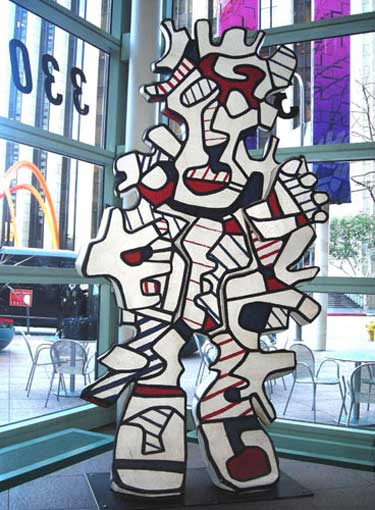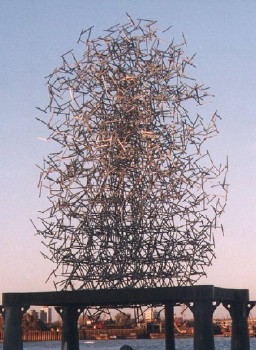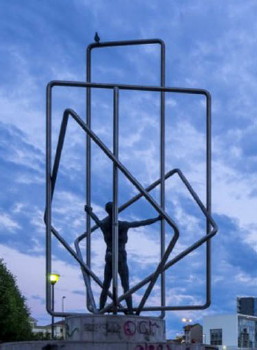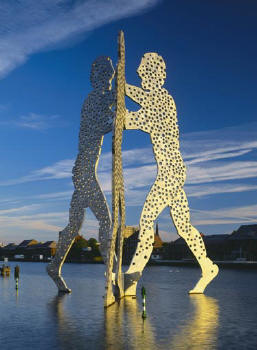Artist:
Jean Dubuffet
Title:
Le Dandy
Year:
1973
Adress:
Wells Fargo Center Court
Making a character
Apparent technical components prove to be enlargements of eyes, mouth, fingers, shoes. The title is Le Dandy. It seems that Jean Dubuffet wanted to expose vanity. It is not clear whether the work is intended as a deconstruction of the character of the person or that it’s making a joke on the person.
By Theo, www.artatsite.com
Compared with other artworks
The artwork Quantum Cloud by Anthony Gormley (London, temporary, picture 1, more information) once stood on a structure inside the Thames, with on the background the elements air and water. This artwork is a good starting point for a creative and meaningful artwork that makes use of the elements which are surrounding the artwork.
This person is incorporated into larger and smaller structures (Human Condition, Agenore Fabbri, Milan, picture 2, more information). It’s a pity for this man that the structures don’t seems to move and therefore this man seems quite lonely.
This statue La Demeure Humanine by Ossip Zadkine (Amsterdam, picture 3, more information) is of a wondrous beauty. The persons are connected with each other and their environment. The material is interesting. The artwork is in dialogue with other coeval works (made by Brague, Piscasso).
This strong woman Mama Branka by Nelson Carrilho (Amsterdam, picture 4, more information) is made of earth, but it is cracked and broken. The woman is looking sad and holding her head slightly turned out of pity. This bronze structure seems to be made of slices of earth. The woman is having her hands nearby and this time this generous woman is not willing to hug. She is apparently full of sorrow and needs time to process this. This is a good and important work.
This artwork structure Molecule Man by Jonathan Borofsky (Berlin, picture 5, more information) is optimistic and is an ode to modern mankind. The persons make close contact with each other, they are standing strong and start to move, they are having fun.
By Theo, www.artatsite.com
www.crala.org:
Soaking up the natural lighting in one of the dining area atriums of the Wells Fargo Center is Jean Dubuffet's 11'h white fiberglass sculpture, "Le Dandy." Energizing the building's entrance and leisure area with its facetious presence, "Le Dandy" can also be seen from the building's exterior through the atrium's glass wall.
www.publicartinla.com:
Epoxy painted with polyurethane. Wells Fargo Court, Bunker Hill, Los Angeles. The sculpture is from the Maguire Thomas Partners collection.
www.crala.org:
Jean Dubuffet (1901- 1985) is a renowned French l’art brut painter, sculptor, lithographer, and writer. He began his journey as an artist in 1918 when he moved to Paris to receive formal training in painting at the Académie Julian. However, within six months the artist left his studies and began painting on his own. As time passed Dubuffet began to doubt the value of art and culture. He stopped painting altogether from 1924-33 and entered the wine trade. It was not until 1942 that Dubuffet began painting again and had his first one-man exhibition at the Galerie Ren Drouin, Paris in 1944. Beginning in 1962, the artist became preoccupied with an extensive series called 'Hourloupe,' which included not only paintings but also painted sculptures and three-dimensional works in polyester resin. Dubuffet’s major works have been collected by several of the world’s leading museums including the Los Angeles County Museum of Art; Guggenheim Museum, Metropolitan Museum of Art, and Museum of Modern Art in New York City; National Gallery of Art, Washington, D.C.; National Gallery of Australia, Canberra; Peggy Guggenheim Collection, Venice; and the Stadel Museum, Frankfurt.
www.wikipedia.org:
Jean Philippe Arthur Dubuffet (31 July 1901 – 12 May 1985) was a French painter and sculptor. His idealistic approach to aesthetics embraced so-called "low art" and eschewed traditional standards of beauty in favor of what he believed to be a more authentic and humanistic approach to image-making. He is perhaps best known for founding the art movement Art Brut, and for the collection of works—Collection de l'art brut—that this movement spawned. Dubuffet enjoyed a prolific art career, both in France and in America, and was featured in many exhibitions throughout his lifetime.
www.christies.com:
Literature
M. Loreau, Catalogue des travaux de Jean Dubuffet, Fascicule XXVIII: Roman Burlesque, Sites tricolores, Paris, 1979, p. 26, no. 16 (small-scale maquette illustrated).
Apparent technical components prove to be enlargements of eyes, mouth, fingers, shoes. The title is Le Dandy. It seems that Jean Dubuffet wanted to expose vanity. It is not clear whether the work is intended as a deconstruction of the character of the person or that it’s making a joke on the person.
By Theo, www.artatsite.com
Compared with other artworks
The artwork Quantum Cloud by Anthony Gormley (London, temporary, picture 1, more information) once stood on a structure inside the Thames, with on the background the elements air and water. This artwork is a good starting point for a creative and meaningful artwork that makes use of the elements which are surrounding the artwork.
This person is incorporated into larger and smaller structures (Human Condition, Agenore Fabbri, Milan, picture 2, more information). It’s a pity for this man that the structures don’t seems to move and therefore this man seems quite lonely.
This statue La Demeure Humanine by Ossip Zadkine (Amsterdam, picture 3, more information) is of a wondrous beauty. The persons are connected with each other and their environment. The material is interesting. The artwork is in dialogue with other coeval works (made by Brague, Piscasso).
This strong woman Mama Branka by Nelson Carrilho (Amsterdam, picture 4, more information) is made of earth, but it is cracked and broken. The woman is looking sad and holding her head slightly turned out of pity. This bronze structure seems to be made of slices of earth. The woman is having her hands nearby and this time this generous woman is not willing to hug. She is apparently full of sorrow and needs time to process this. This is a good and important work.
This artwork structure Molecule Man by Jonathan Borofsky (Berlin, picture 5, more information) is optimistic and is an ode to modern mankind. The persons make close contact with each other, they are standing strong and start to move, they are having fun.
By Theo, www.artatsite.com
www.crala.org:
Soaking up the natural lighting in one of the dining area atriums of the Wells Fargo Center is Jean Dubuffet's 11'h white fiberglass sculpture, "Le Dandy." Energizing the building's entrance and leisure area with its facetious presence, "Le Dandy" can also be seen from the building's exterior through the atrium's glass wall.
www.publicartinla.com:
Epoxy painted with polyurethane. Wells Fargo Court, Bunker Hill, Los Angeles. The sculpture is from the Maguire Thomas Partners collection.
www.crala.org:
Jean Dubuffet (1901- 1985) is a renowned French l’art brut painter, sculptor, lithographer, and writer. He began his journey as an artist in 1918 when he moved to Paris to receive formal training in painting at the Académie Julian. However, within six months the artist left his studies and began painting on his own. As time passed Dubuffet began to doubt the value of art and culture. He stopped painting altogether from 1924-33 and entered the wine trade. It was not until 1942 that Dubuffet began painting again and had his first one-man exhibition at the Galerie Ren Drouin, Paris in 1944. Beginning in 1962, the artist became preoccupied with an extensive series called 'Hourloupe,' which included not only paintings but also painted sculptures and three-dimensional works in polyester resin. Dubuffet’s major works have been collected by several of the world’s leading museums including the Los Angeles County Museum of Art; Guggenheim Museum, Metropolitan Museum of Art, and Museum of Modern Art in New York City; National Gallery of Art, Washington, D.C.; National Gallery of Australia, Canberra; Peggy Guggenheim Collection, Venice; and the Stadel Museum, Frankfurt.
www.wikipedia.org:
Jean Philippe Arthur Dubuffet (31 July 1901 – 12 May 1985) was a French painter and sculptor. His idealistic approach to aesthetics embraced so-called "low art" and eschewed traditional standards of beauty in favor of what he believed to be a more authentic and humanistic approach to image-making. He is perhaps best known for founding the art movement Art Brut, and for the collection of works—Collection de l'art brut—that this movement spawned. Dubuffet enjoyed a prolific art career, both in France and in America, and was featured in many exhibitions throughout his lifetime.
www.christies.com:
Literature
M. Loreau, Catalogue des travaux de Jean Dubuffet, Fascicule XXVIII: Roman Burlesque, Sites tricolores, Paris, 1979, p. 26, no. 16 (small-scale maquette illustrated).








